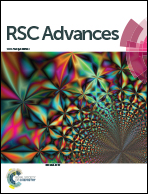Shedding light on hydroxyquinoline-based ruthenium sensitizers with a long-lived charge carrier to boost photocatalytic H2 evolution†
Abstract
Three new hydroxyquinoline-coordinated ruthenium(II) sensitizers bearing a polypyridyl derivative anchor (R1, R2 and R3) were synthesized that could tether to visible light sensitization over a Pt–TiO2 system for hydrogen production. The highest hydrogen production yield of 225.2 μmol was obtained and a turnover number (TON) of 1734 (for 6 h) over R1/Pt–TiO2. The photoactivity of the as-prepared sensitizers was found to be predominantly influenced by the longer lifetime of the metal-to-ligand-charge transfer (MLCT) states and suitable redox properties of Ru(II) species in the heteroleptic complexes. Measurement of the binding kinetics revealed a comprehensive relationship between the adsorption behaviour of dyes onto a TiO2 surface and ligand influence on the hydrogen evolution activity. The dependence of the hydrogen generation rate was systematically screened at different dye concentrations (0.05–1.0 μmol/10 mg TiO2) and the results were correlated with their pertinent adsorption properties. The operational parameters like, pH of the medium and noble metal loading were taken into account for optimal photocatalytic performance.


 Please wait while we load your content...
Please wait while we load your content...